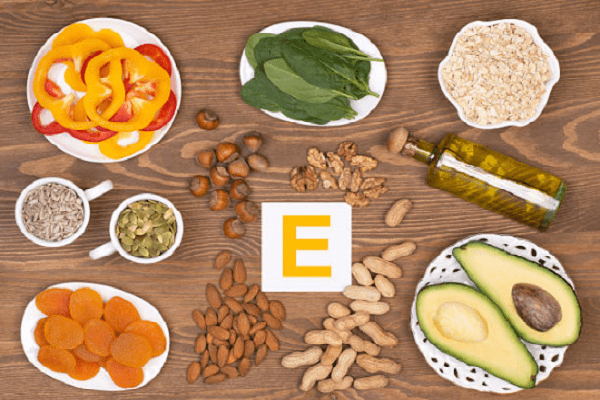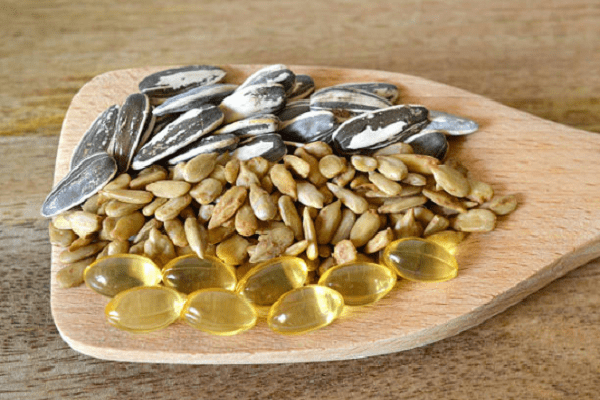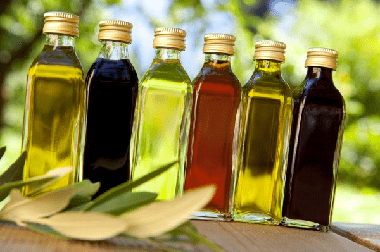Vitamins and minerals >>>> Vitamin E
Vitamin E.

Vitamin E is the name given to eight fat-soluble species of compounds (vitamers E), which are divided into classes: tocopherols and tocotrienols. Each of the E vitamers has a different degree of biochemical activity and, depending on this, various medicinal preparations of vitamin E are formed, which have antioxidant properties and vitamin activity to varying degrees (the strongest vitamins are alpha, beta and gamma tocopherols, the most powerful antioxidant is delta -tocopherol).
In nature, alpha-tocopherol is most often found, it is also taken as the starting point for the activity of other vitamers E, and the calculation in preparations is carried out in comparison with the activity of 1 mg (1ME) of alpha-tocopherol.

Entering the digestive tract, oils and other foods containing vitamin E are hydrolyzed by enzymes and release the vitamin itself, which enters the bloodstream and penetrates into various organs and tissues. If the functions of the gastrointestinal tract are not impaired, then the intestine is able to absorb up to 50% of all vitamin E. Vitamin E is excreted from the body in the form of metabolites or unchanged through the intestines with feces (90%), through the kidneys with urine (10%).
With an excessive intake of vitamin E into the body, it tends to accumulate in adipose tissue, liver, adrenal glands, muscles, pituitary gland, testes and create a depot. Excessive amounts of vitamin E in the body (hypervitaminosis E) can lead to dysfunction of some organs and organ systems.
The functions of vitamin E in the body are quite diverse:
- It improves blood microcirculation and promotes the growth of collateral vessels (vessels that take on a role in the blood supply to tissues in case of impaired patency or damage to the vessels of the main bed),
- Improves the rheological properties of blood and acts as a prophylaxis for atherosclerosis, thrombophlebitis and other vascular diseases,
- Accelerates regeneration processes in tissues (especially when paired with vitamin A), slows down the aging process of cells,
- Slows down the rate of formation of free radicals, and therefore the oxidation processes,
- Able to bind with active oxygen compounds, forming stable structures,
- Improves the functionality of muscle tissue, creates an anticonvulsant effect,
- Reduces the risk of tissue malignancy,
- Affects immune responses - is responsible for the level of immunoglobulins, restores the number and activity of T- and B-lymphocytes,
- Vitamin E is a good antihypoxant - it is able to stabilize the mitochondrial membrane (reduce its throughput), thereby inhibiting the consumption of oxygen by cells (oxygen is economically consumed), and also participates in the synthesis of ubiquinone - one of the components of the respiratory process in mitochondria,
- Counteracts degenerative processes in the nervous tissue, Vitamin E is a regulator of growth and proper development of the body,
- Vitamin E has established itself not only as an antioxidant and antihypoxant, but also as a compound that affects reproductive function. Even during the discovery of this vitamin, it was noticed that its absence in the diet of animals affects their reproductive activity and is fraught with infertility.
Foods containing significant amounts of vitamin E:
Vegetable oils:
Sunflower, corn, sesame, peanut, sea buckthorn, soybean, etc.
Cereals:
Buckwheat, wheat, corn, pearl barley, oatNuts:
Peanuts, pistachios, hazelnuts, cashews, almonds, etc.
Seeds:
Sunflower, pumpkin
- Salads and salad varieties of cabbage,
- Egg yolks,
Legumes:
Soybeans, peas, beans
Seafood:
Squid, shrimp, lobster, pike perch, mackerel.

Vitamin E preparations are produced in the form of an oil solution, in capsules, in tablets, dragees, lozenges, and powder. Oil solutions and vitamin E capsules do not require additional support in the form of oil supplements for assimilation, but the most effective intake of vitamin E occurs in the presence of vitamin A, and some dosage forms include both of these vitamins (Vetoron, Aevit).
Vitamin E preparations can be made from natural ingredients (plant extracts or animal raw materials) or synthesized with an exact repetition of the tocopherol formula.
The dosage is chosen depending on the age (1 mg = 1 IU):
- Children in the first year of life: 3-5 IU
- Children from 1 to 6 years old: 5-7 IU
- From seven years old and adults 10 - 15 IU
Vitamin E is taken in order to improve immune responses and antioxidant processes in the body, to improve reparative processes in tissues (regeneration), to eliminate vitamin E hypovitaminosis, to slow down aging processes, when planning pregnancy and carrying a child, in the treatment of a number of diseases (including including: skin, hormonal, with a violation of hematopoiesis).
Hypovitaminosis E manifests itself in muscle weakness, the development of muscular dystrophy, impaired growth and development of the child's body, impaired reproductive function, disorders of the heart muscle, metabolic disorders associated with oxygen metabolism.
Vitamin E is better absorbed in the presence of vegetable fats or oils, it is destroyed in the light (for this very reason, you should not store oil in a transparent container made of light glass).

Read

Read



























